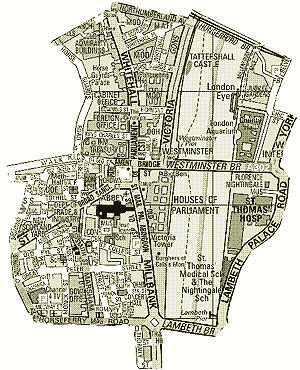This entry was posted on
Friday, January 20th, 2006 at
10:25 am and is filed
under The War on Stupid.
The police have belatedly charged Maya Evans’ co-demonstrator, Milan Rai, with “organising” the demo for which Maya was prosecuted.
(Wow… does this classify as a new ‘target the head’ policy?)
Am I next? Well, the police did said that: “We treated the event as a carol service and not as a demonstration so the legislation did not come into play.”
But they may very well change their minds… especially if this person is a policeman, as many suspect he is. After all, this legislation has – so far – been used exclusively on those who cause Tony Blair embarrassment.
I think potentially outing one of his storm-troopers qualifies… perhaps they will find a way to serve a retro-active burger with the works. Let’s see if I can’t give them a helping hand:
On Saturday 14th Jan 2006, I went on a little pilgrimage to the exclusion zone, and gathered some data. I began with a map and the limits of the zone as defined by The Serious Organised Crime and Police Act 2005 (Designated Area) Order 2005:
For the purposes of sections 132 to 137 of the Serious Organised Crime and Police Act 2005, the designated area is the area bounded by an imaginary line starting at the point where Hungerford Bridge crosses Victoria Embankment, continuing along Hungerford Bridge to the point where it crosses Belvedere Road, rightwards along Belvedere Road as far as Chicheley Street, leftwards along Chicheley Street as far as York Road, rightwards along York Road, crossing Westminster Bridge Road into Lambeth Palace Road, along Lambeth Palace Road as far as Lambeth Bridge, over Lambeth Bridge, leftwards along Millbank as far as Thorney Street, along Thorney Street as far as Horseferry Road, leftwards along Horseferry Road as far as Strutton Ground, along Strutton Ground crossing over Victoria Street into Broadway, along Broadway as far as Queen Anne’s Gate, along Queen Anne’s Gate as far as Birdcage Walk, rightwards along Birdcage Walk as far as Horse Guards Road, along Horse Guards Road as far as the Mall, rightwards along the Mall, across the north end of Whitehall as far as Northumberland Avenue, along Northumberland Avenue as far as Victoria Embankment, leftwards along Victoria Embankment returning to the starting point.

Exclusion Zone Fact #1 – It would take the average person 60 to 90 minutes to walk this perimeter (it took me 72 minutes).
Exclusion Zone Fact #2 – From start to finish, this involves just 6,983 steps.
Exclusion Zone Fact #3 – The perimeter extends much further beyond Parliament than MPs were expecting when they voted on the Act and, at its very limits, it just happens to cover Labour HQ, both branches of the Home Office and Scotland Yard (i.e. the people responsible for introducing it, and the people responsible for enforcing it).
Exclusion Zone Fact #4 – The exclusion zone has within it over a dozen memorials, including – at the north-western extremity – the National Police Memorial. Because the Act does not define what constitutes a demonstration, even if you wish to do something as simple as lay a wreath at any of these memorials, you will first need to apply for permission. (In writing. Six days in advance.)
Exclusion Zone Fact #5 – In practical terms, the exclusion zone extends even further than its suggested perimeter. As the Act states; “references to a named street or other highway include the pavements adjoining that street or other highway on the extremity of the designated area.” This means that you can’t protest on any road that defines the perimeter, or on the pavement across that road (with the oh-so-generous exception of Trafalgar Square) and in most cases, what’s on the other side of that pavement is a building. So unless you’re a major property owner, you are shit out of luck, fella (see; this same Act on private property and Crown land). Also, if you’re thinking of standing in a side street, think again; the Act is worded so clumsily (or cleverly, depending on your point of view) that the exclusion zone can actually be interpreted to include the pavements on any adjoining highway at the extremity of the perimeter and/or that entire highway itself. The whole perimeter is – effectively – another city-block wider… potentially with tendrils extending far beyond that (though , as it says here, for no more than “one kilometre in a straight line from the point nearest to it in Parliament Square”). The graphic below uses the main branch of the Home Office as an example:

Exclusion Zone Fact #6 – There are eight primary locations along the perimeter where you can actually see Parliament (but Parliament cannot see you). Unless you take the above into account, in which case there are two.
Exclusion Zone Fact #7 – In researching all of the above, I have taken steps (6,983 of them, in fact) to demonstrate the full extent of the exclusion zone… and I was within the exclusion zone the entire time I was organising and taking part in the aforementioned demonstration (with the exception of data-posting, which has been done from the comfort of my suburban web-shed). This means that – technically – I am guilty of an offence under this Act and liable to imprisonment for a term not exceeding 51 weeks.




By Parliament Protest January 22, 2006 - 1:54 am
Is the SOCPA Designated Area actually bigger than we have assumed ?
Tim Ireland has an interesting posting on Bloggerheads, which suggests that he might also be at risk of being considered an “organiser” of a demonstration without prior written approval, by “beating the bounds” around the Desgnated Area. The other inte…
By D-Notice January 22, 2006 - 7:33 pm
It’s people like you who are bringing this country down from within!Hanging’s too good for you!… ahem…
By D-Notice January 22, 2006 - 7:47 pm
Just thought, what if you hold a demonstration in Westminster tube station? Would that be covered?How about holding one on the tube train itself in-between stops?How far down does the “Designated Area” go?